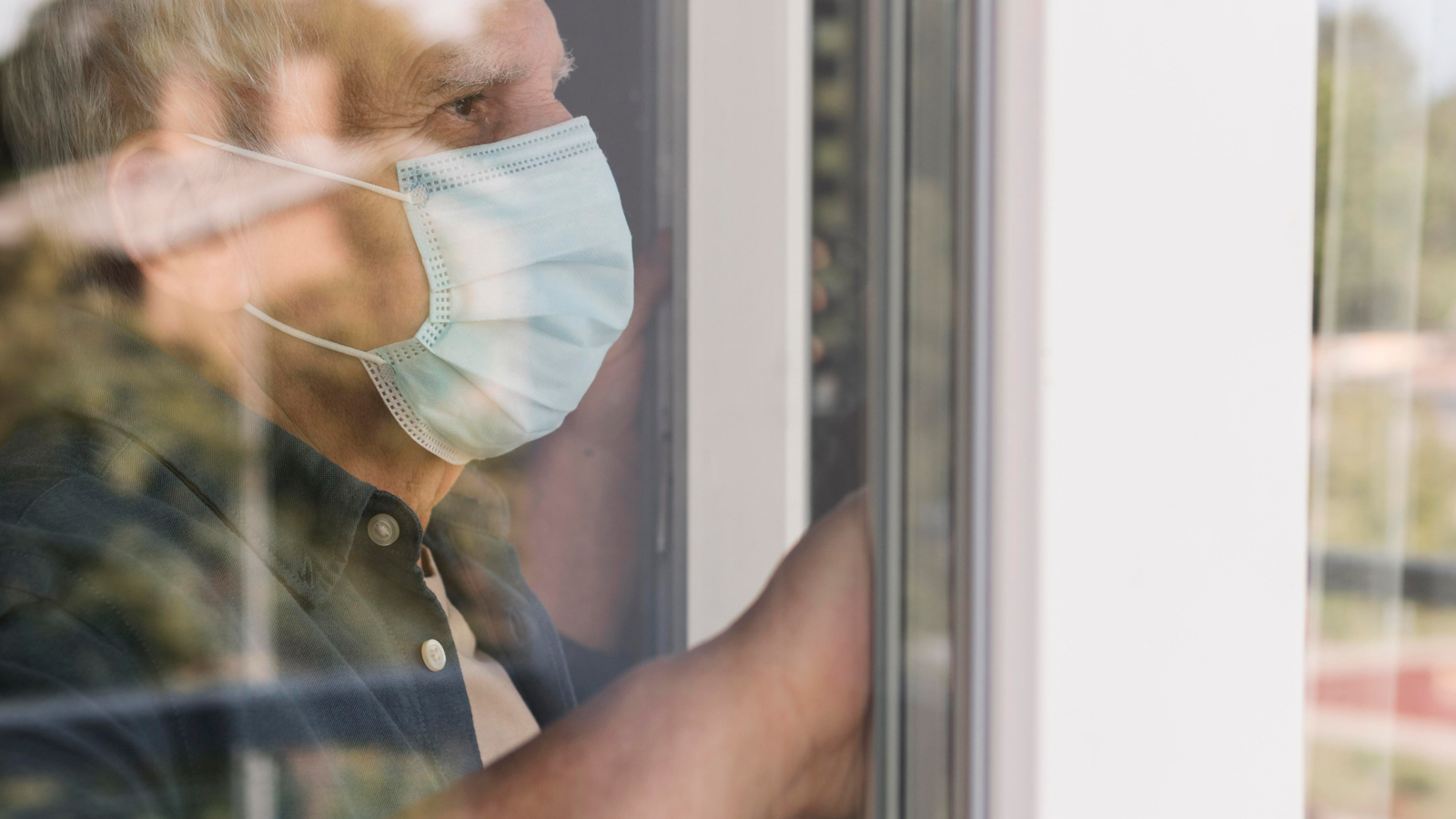
20 Questions to Ask Your Nursing Home during COVID
Whether you have a loved one currently in a nursing home or rehabilitation facility, or whether you’re shopping for one, you should arm yourself with a list of questions to gauge how safe the environment is. Here’s a guide to those questions, and the answers you should expect.

Mary Houston’s dad has been in a nursing home for three years. It was a stressful decision to move him from the Cleveland-area home where he lived alone, but the family knew it was the best option. Bill Prebel suffers from Parkinson’s disease and had fallen more than 100 times in one year.
Houston is happy with Lutheran Home at Concord Reserve in a suburb of Cleveland, but the last seven months have been filled with worry since the COVID-19 pandemic hit. She’s seen her 89-year-old father in person only twice since March. The other times have been through windows. Sure, they talk on the phone and do regular Zoom video calls, but he doesn’t hear well. She misses holding his hand and giving him a hug goodbye.
“It’s been horrific,” Houston said.
One thing that has helped the family cope: Houston said the nursing home staff has done a fantastic job of communicating with residents proactively and always responds to her questions. She’s had lots of questions.
She’s had to learn what questions to ask during a pandemic. This is new to all of us. Are residents eating together or alone? How often are employees tested for the virus? Are new residents tested and quarantined?
Whether you have a loved one currently in a nursing home or rehabilitation facility, or whether you’re shopping for one, you should arm yourself with a list of questions to gauge how safe the environment is. Here’s a guide to those questions, and the answers you should expect.
Questions to ask:
1. Does the home screen staff daily (i.e. temperature checks)?
They should. The Centers for Disease Control and Prevention Services says all homes should evaluate all health-care professionals at the beginning of their shift by taking their temperature, and asking about and looking for symptoms of COVID-19.
2. Does the home test all residents? How often?
The Centers for Medicare & Medicaid Services (CMS) says residents in nursing homes are at “high risk” for infection, serious illness and even death from COVID-19. In most states, a disproportionate number of cases have emerged within nursing homes. In some nursing homes nationwide, one initially unidentified case spread like wildfire, infecting a majority of residents and some staff as well. In some tragic cases, more than half of a home’s residents died.
It all starts with testing. The capacity of the nation’s more than 15,000 nursing homes to conduct widespread testing has certainly improved since March, but it’s by no means easy or performed across the board. CMS says nursing homes “should have a plan for testing residents” for the virus that causes COVID-19.
CMS’s guidance — guidance but not necessarily a requirement — on this has changed numerous times over the months. Whether a home is required to test all residents and how often varies by state.
But testing all residents at regular intervals, perhaps every week or two, allows the home to quickly isolate residents and identify staff members and other residents who may have had contact with the infected person. CMS says homes should aim for rapid tests, meaning results come in less than 24 hours so action can be taken. Without testing, asymptomatic staff and residents can infect others. So it’s important for a nursing home to have a plan and the capacity to perform testing of all residents.
The standards are different if someone is showing any symptoms, such as respiratory issues or a fever. (Yes, every resident’s temperature should be taken every day.) These residents should be tested immediately.
The standards are also different if any resident or staff has a confirmed case. In fact, infection in a resident “should be considered an outbreak,” CMS says. “When one case is detected in a nursing home, there are often other residents and (health care professionals) who are infected with SARS-CoV-2 who can continue to spread the infection, even if they are asymptomatic. Performing viral testing of all residents as soon as there is a new confirmed case in the facility will identify infected residents quickly” to address the risk and prevent spread.
3. Does the home regularly test all staff? How often?
For nursing homes that don’t allow outside visitors, the biggest risk of introducing the virus into the home lies with staff — both employees and independent contractors.
The American Health Care Association and National Center for Assisted Living (AHCA/NCAL) says a spike in cases that started in late June at nursing homes and other long-term care facilities nationwide can be traced to community spread. It’s being brought in from the outside.
Nursing home advocates say workers should be tested regularly. Period. Weekly would be ideal; every other week is common. Some states require testing of all nursing home staff at regular intervals. These rules also are rapidly changing.
CMS at the end of August updated its guidance, saying nursing homes must test staff once a month if the county where a home is located has a positivity rate of less than 5 percent. If the county positivity rate is between 5 percent and 10 percent, staff should be tested at least once a week. If the county positivity rate exceeds 10 percent, staff should be tested at least twice a week.
4. Does the home regularly test all vendors?
As with employees, all outside vendors should be tested regularly. Outside vendors could be more at risk of contracting COVID-19 because they generally work in various facilities. The more interaction with more people, the bigger the risk. Vendors may include people who make food deliveries, perform maintenance, take in oxygen and other supplies, etc. Vendors should be screened daily and tested regularly.
5. Does the home notify residents and families if there’s a positive test among residents or staff?
They should. Under CMS rules adopted in April, nursing homes are required to disclose any case of COVID-19 to all residents and their designated family member or responsible party, in addition to notifying health authorities. This notification is required within 12 hours after the case is confirmed.
The home is also required to report to residents and their representatives within 12 hours if there’s a resident with a respiratory infection who is hospitalized or dies, or if three or more residents or staff members come down with respiratory symptoms within a 72-hour period.
6. How does the home handle COVID positive residents to protect other residents and staff?
Ideally, a home would have a separate wing for COVID positive residents. In addition, homes able to provide an additional layer of protection will have specific staff assigned only to COVID residents and no others on any given day.
7. Does the home have a leave policy for staff who show symptoms or may have been exposed – and what is the plan to replace them?
The CDC recommends that nursing homes and other senior facilities adopt flexible, non-punitive sick leave policies so workers can stay home or self-isolate if they are experiencing symptoms or have someone in their home who is infected. In the case of some administrative or back-office jobs, the person may be able to work from home.
An inferior sick leave policy might force staff who have symptoms to go to work just to keep their job. This creates greater risk to co-workers and residents. Staff should be able to stay home without fear of retaliation if they are sick, and they should be able to get an easy test so they can go back to work when they feel ready.
Health care professionals and others who work in nursing homes should be educated about not reporting to work when they’re not feeling well. This includes contractors such as podiatrists or barbers. Consultants are important because they provide services in multiple facilities and can be easily exposed and then spread the virus to many, many others quickly.
Again, the home may need to turn to temporary staffing companies or contract nurses to fill gaps.
8. Does the home require all new admissions to be tested?
AARP says it’s smart for homes to test all new admissions. Anyone being transferred from a hospital to the home should have been tested immediately before discharge. The nursing home should consider quarantining the newly admitted resident regardless of the test outcome for seven to 10 days and re-test again. New admissions shouldn’t be allowed in common areas until they complete the quarantine period.
9. Are residents allowed to go outside on the grounds, such as a courtyard, to get fresh air?
They should be allowed, as long as there are no active or suspected COVID cases in the home and residents can go outside safely and with social distancing, according to the National Consumer Voice for Quality Long-Term Care of Washington D.C. A home’s management should communicate policies and expectations clearly, Consumer Voice said.
If a home has active or suspected cases, then the CDC says residents should be restricted to their rooms except when medically necessary.
10. Does the home allow outdoor visits from loved ones? For how long? How often?
New CMS guidance says that if a home doesn’t have any confirmed or suspected COVID-19 cases, then outdoor visits should be “facilitated routinely.” Homes should still enforce social distancing and limit the number of visits and number of visitors to reduce the risk of infection.
But nursing homes that don’t have enough outdoor space, personal protective equipment (PPE) or cleaning supplies may not be able to offer outdoor visits easily, according to AARP. In addition, be prepared to fill out extra paperwork required in some states or by some homes. (PPE includes N95 masks, surgical masks, gowns, eye protection, gloves and hand sanitizer. Most nursing homes nationwide juggle these supplies and rarely have the extra supplies on hand that are recommended.)
11. Does the home allow indoor visits beyond end-of-life situations? For how long? How often?
Until last month, nursing homes generally didn’t allow indoor visits except under a strict definition of “compassionate care.” That generally meant an end-of-life situation, to say goodbye. Now, under new CMS guidance, nursing homes have more flexibility in allowing indoor visitation. One big exception: No visitation is allowed if the home has experienced any new COVID-19 cases in the last 14 days or if the home is investigating a suspected outbreak.
Further, if a home is in a county with a positivity rate exceeding 10 percent, only compassionate care visits are allowed. But the definition of compassionate care has broadened to include visits for a new resident who’s having difficulty adjusting to the new environment, visits to help someone who seems to be emotionally distressed or depressed or visits to help a loved one with eating or drinking if he or she is losing weight or is dehydrated.
12. Can residents participate in group activities before reaching phase 3 of the nursing home reopening plan?
Phase 3 is a final reopening phase that has strict criteria, including: the home must have enough PPE, appropriate cleaning and disinfection supplies, no staffing shortages, access to adequate testing and no new COVID-19 cases contracted in the home in the last 28 days.
CMS says some homes may have communal activities and dining, as long as they observe best practices of COVID-19 infection transmission, including social distancing, face coverings, and limiting the number of people in a room.
Activities could include book clubs, crafts, movies, exercise and bingo, CMS says, because all could be done while observing best practices to reduce risk.
One idea may involve activities for residents in groups, for example, those who have had COVID-19 and are fully recovered, and those not suspected to have it.
13. Do workers have adequate PPE to keep themselves and their patients safe?
Nursing homes are expected to have six different types of PPE available for staff: N95 masks, surgical masks, eye protection, gowns, gloves and hand sanitizer. Unfortunately, significant numbers of nursing homes don’t have adequate PPE.
You can look up whether a home has had shortages of any type of PPE at any point since May. (This video shows you how to look up an individual home.) If a home doesn’t have enough PPE, AARP says, you should ask the home what’s being done to address the problem.
14. What is the home doing to help residents stay connected with their families or friends?
We’ve all seen images of people doing window visits with loved ones. But that only works if the resident has access to a first-floor window.
Do staff help residents with phone calls/ video calls? Does the home have smart phones residents can use for FaceTime or video calls? Many residents may not have a smart phone with those capabilities.
AARP recommends asking if the home can set up a regular schedule for residents to take phone calls or video calls from loved ones.
15. How does the home communicate important information to residents and families on a regular basis?
Is it by phone or text or email? How often will the home send out updates that aren’t urgent but are important? Maybe once a week? You should know what to expect.
16. Is the home at full staffing levels for nurses, aides, clinical staff and other workers?
You should ask what percentage of positions are open and what is being done to fill them, AARP says. Further, you should ask how the home meets residents’ basic needs like help with daily temperature checks, feeding, medication and bathing if the home has staffing shortages. The home may be relying on temporary staffing or contract nurses, which is better than having staffing shortages, as long as they’re screened the same as employees.
17. What does the home do to reduce/ prevent transmission?
Big picture: The CDC and CMS say homes should limit visitation, screen residents daily for fever and other COVID-19 symptoms, require all staff to wear masks and offer flexible sick time to allow workers experiencing possible symptoms to stay home. Consumer Voice says staff should:
- Wear PPE.
- Wash their hands or use hand sanitizer before and after each encounter with a resident, after using medical equipment and after taking off PPE.
- Make sure alcohol-based hand sanitizer is in all resident-care areas, including inside and outside of rooms.
- Clean residents’ hands before they eat and after they use the toilet.
- Clean and disinfect medical equipment between uses.
In addition, the home’s management should complete a special assessment instituted by the federal government to make sure the home’s infection control plan and protections are properly addressing COVID-19 issues. Homes should also communicate regularly with local and state Departments of Health, emergency management offices and the CDC about conditions inside the home, ask for resources and the latest information and ask for help, if needed.
18. What tests/ procedures are available on site, such as X-rays, dialysis, etc.)?
If a home doesn’t have on-site access to many diagnostic and treatment services, residents would have to go to a hospital or other facility, which increases the chance of exposure to COVID.
19. Does the home have a telemedicine portal?
It should. This gives residents instant access to a visit with a nurse practitioner or doctor. Some homes, if they get a positive or suspected case, will shut the home down to any outsiders. That can make it difficult for residents to get a proper medical consultation.
20. Does the home regularly report its COVID data to CMS?
Nursing homes are required to report nearly 80 types of data to CMS every week, including COVID cases, deaths, staffing shortages, PPE shortages and testing numbers and results. CMS expects homes to be accountable to the government and to the public. If a home isn’t submitting the required data, why not? When will it commit to doing better? If this is a home you’re considering for a future need, and it’s not reporting any data, you may want to find out more or cross it off your list.
To download a PDF of this report, go to https://uspirg.org/sites/pirg/files/reports/NursingHomeSafetyDuringCOVID…
If you need help:
Long-term care ombudsman offices and citizen action groups help consumers with questions about nursing homes and other long-term care facilities. If you’re concerned about the quality of care or need help resolving a problem, they can help.
To find ombudsman offices and advocates in your community, use this map provided by Consumer Voice:
https://theconsumervoice.org/get_help
To find and compare nursing homes:
https://www.medicare.gov/nursinghomecompare/search.html?
For information on star ratings:
https://www.cms.gov/Medicare/Provider-Enrollment-and-Certification/CertificationandComplianc/FSQRS
Topics
Find Out More


Fixed for the Holidays

Trouble in Toyland 2023

